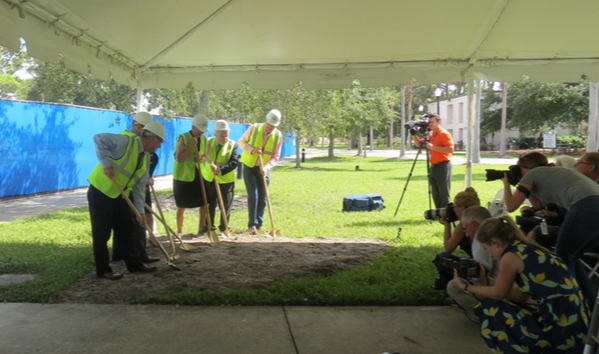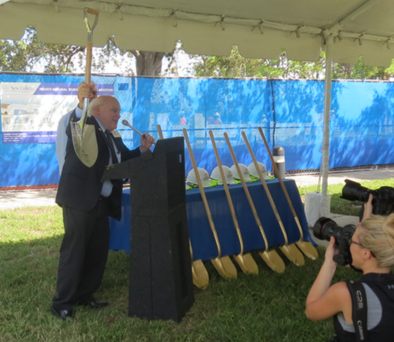
In a sea of rankings and statistics, it’s easy to lose track of where New College stands. However, every once in awhile, one sticks out. Case in point: unbeknownst to many, our tiny liberal arts college on the bay produces the third highest proportion of science and engineering PhDs when factored in the National Center for Science and Engineering Statistics’ research on the matter – solidly ahead of the quantitatively esteemed Massachusetts Institute of Technology.
This is how President Donal O’Shea began his speech at the Heiser Natural Sciences Complex (HNS) addition’s Groundbreaking Ceremony on Tuesday, Oct. 19. Covertly concealed behind a large blue gate in the center of Bayfront Campus, construction is well underway on the nearly 10 million dollar project, which will house a variety of faculty offices, classrooms, labs and gathering spaces for the Natural Sciences and beyond.
“The Heiser addition will have a major effect on the campus as a whole,” O’Shea said in an email interview. “It will complete the science complex, creating a highly connected space that is more welcoming to all students, and more supportive of serendipitous encounters among faculty and students.”
How it happened
“Students work really closely with faculty members – and for that you need lab space, you need students working with other students, you need spaces for them to congregate,” O’Shea explained in his speech at the Groundbreaking Ceremony. “And we were totally maxed out on space.”
Professor of Biochemistry and Division Chair Katherine Walstrom detailed the addition’s history, which dates back to the original building’s construction. A problem reduced the size of that original building by about a third, causing the space to now be quickly outgrown. Acknowledging the lack of space, Professor of Biology Sandra Gilchrist submitted a proposal for a new wing to the Board of Governors’ list of projects to fund around 12 years ago.
“The original plan was for growth with appropriate space for the sciences,” Gilchrist said in an email interview. “We were in E building with two of our faculty at that time and ACE was not on line.”
Professor of Chemistry Paul Scudder dug up the original building’s plans, which proved that some of the space was cut during construction, further convincing the Board of Governors’ to recommend the Heiser addition project to the State Legislature.
Built a few years back, the Academic Center (ACE) was ahead on that Board of Governor’s list. Once projects get completed, others get moved up the list – and eventually it was the Heiser addition’s turn to receive funding.
The blueprints
A total of 9.7 million dollars will be allocated to the project once it’s complete, according to Coordinator of Construction Projects John Milton. The estimated breakdown of funds is as follows: $600,000 was granted two years ago for design, another 7.3 million dollars was granted up to this year for construction, and another 1.8 million dollars is to be granted for equipment and furniture.
Construction began in August and – if no weather or production delays slow down the process – is slated to finish by next school year.
Also, according to Milton, the architecture company was chosen by advertising the project, inviting design proposals and scoring them based on quality of staff and experience, and hosting presentations for a selected few. In the end, Harvard Jolly – which has worked with educational facilities, including labs, in the past – was hired. Tandem Construction was hired as well.
The open breezeways in the original HNS building are to be closed off, air conditioned and connected to the new addition. HNS 1.0 will also be painted to match the new addition, which will pick up on ACE’s current color, uniting the campus’ buildings.
In the new complex’s center, where the old building and the new building meet, plans for a lobby are in place, which include seating for all visitors. The Natural Sciences division office and the Chair’s office will be relocated to that lobby from their present home inside the mathematics wing.
Currently, the undergraduate computer science professors and graduate data science professors are located on the third floor of the Academic Center (ACE), far away from their collaborators in HNS, due to the lack of space. These faculty will be moved into the HNS addition’s first floor, clearing out those ACE rooms.
“Computer science courses are currently sporadically located in Hamilton Classrooms, ACE and Heiser, which I think unintentionally fragments the entire department. Having a central location will definitely help make the department feel more structured,” first-year Parankush Bhardwaj said in an email interview.
A physics lab is to sit down the first floor’s hallway. Upstairs, more faculty offices will line the hallway, along with biology and chemistry labs.
One key aspect of these plans is room for growth, an area where the original HNS building fell short. What are currently designated as classrooms on both floors of the new building can be converted into future labs, a proactive attempt to contain growth under one roof.
The Building Committee consisted of Gilchrist, Scudder, Professor of Mathematics Patrick McDonald, Professor of Physics George Ruppeiner and Walstrom as Chair.
Green initiatives
Like ACE, the new Heiser addition will be Leadership in Energy and Environmental Design (LEED) Certified, under its silver status. Local and reusable material is to be used for the construction, creating an energy efficient building complete with electric vehicle chargers in its parking lot.
Vice President of Green Affairs Orion Morton says that the Council of Green Affairs (CGA) plans to provide funding for solar panels on the new addition, though it’s still tentative. The idea has been in the works for a few years, but last year the CGA was informed by administration that solar panels were no longer possible. After moving forward with other projects, the CGA was once again contacted at the beginning of this year – but this time by Physical Plant, who wanted to discuss solar panels for the building.
“I’m not entirely sure what happened with them telling us all of that last year, but I’m glad we’re able to move forward,” Morton said in an email interview. “The CGA and the Green Fee were actually established with alternative energy (specifically solar) as the primary focus, so it’s satisfying to see that original intention finally coming to fruition. The funding is coming from the Green Fee, which comes from a per-credit-hour fee (like the health/athletic fee) paid by students.
“The installation of solar panels on the new addition is definitely a good start to improving our environmental footprint, though there’s still so much to be done. The panels will only offset a portion of the energy used by the new addition, not all of it – but there’s room to install more in the future,” Morton continued. “We’re viewing this initial installation as a catalyst for more panels to be added to campus in the future, since these will be our first.”

Community effect
Another key aspect of the new Heiser addition is collaboration space for students in every discipline to use. Hallways on the building’s second floor will be widened and outfitted with seating. Also on the second floor, a terrace with seating will hang over the entrance, and the landscape outside the complex will be transformed into another gathering space for campus denizens to enjoy lunch, work together and study.
Citing a paper she read, Walstrom emphasized the complex’s collaborative layout, forcing students and faculty in different fields to constantly pass each other through the hallways.
“Everybody in the whole Division has had input in the process,” Walstrom said.
Speaking on within-sciences collaboration, Bhardwaj said, “I’m really excited about the idea of prospective collaboration between computer science and the other science departments.
“Physics and computer science should be better integrated for students wanting to understand the hardware portion of computers,” he continued. “The opportunities are endless, even students concentrating in biology or chemistry can use the computer science department to learn how to simulate complex science experiments digitally.”
During her speech at the Groundbreaking Ceremony, Walstrom notes, “When we designed the gathering places for the new wing, we were hoping that they will become a destination for all New College students – and not just the Natural Sciences.”


Pingback: Ground is broken for new Heiser addition | Caitlyn Ralph